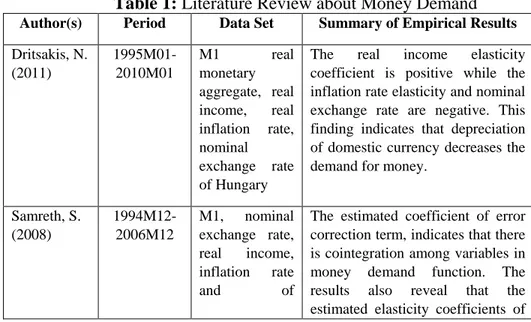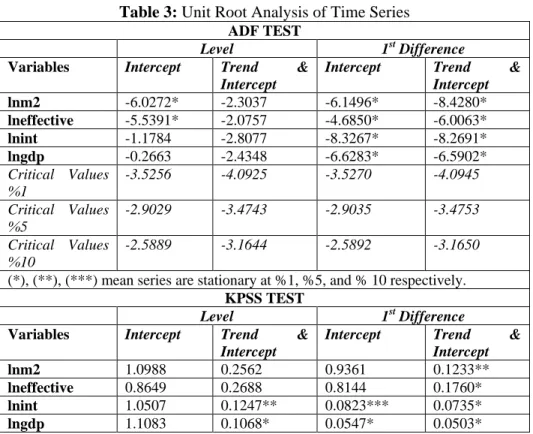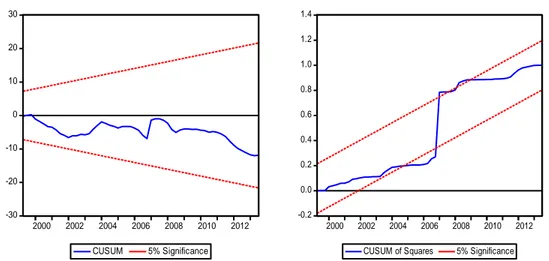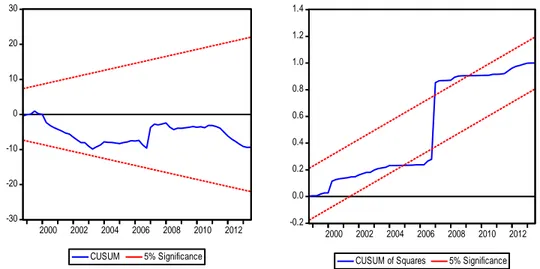Sosyal ve Ekonomik Araştırmalar Dergisi (The Journal of Socialand Economic Research) ISSN: 2148 – 3043 / Ekim 2014 / Yıl: 14 / Sayı: 28
MONEY DEMAND FUNCTION IN TURKEY: AN
ARDL APPROACH
Melih ÖZÇALIK
Abstract
This paper examines the long run and short run dynamics of M2 money demand with effective exchange rate, weighted interest rate of one month term deposits and quarterly seasonally adjusted gross domestic product. Monthly data between 1995Q4-2013Q3 has been taken to estimate linkage between M2 monetary aggregate and macroeconomics factors. The Autoregressive Distributed Lag (ARDL) approach which is accepted as an analytical cointegration techniqueis used to determine the short-run and long-run relationships. According to results we found a long-run and short-run relationship between M2 and interest rate and GDP. CUSUM and CUSUM-Q tests indicate money demand function is stable in the first test, while it’s not stable in the second test even in the long-run and short-run.
Key Words: Money Demand, Turkey, ARDL Jel Codes: E41, E51, C32
1- Introduction
The information on the structure of money demand function is very important for policy makers in monetary policy (Samreth, 2008: 2). The money demand function creates a background to review the effectiveness of monetary policies, as an important issue in terms of the overall macroeconomic stability (Dritsakis, 2011: 2). The demand for money is one of the key functions in formulating appropriate monetary policy. For this purpose there is a need to have understanding the monetary aggregates which need to be controlled by monetary authorities (Anwar and Asghar, 2012: 1). The demand for money function is a basic element in conducting monetary policy by making it possible for monetary authorities to effect changes in macroeconomic variables such as income, interest rate and prices by appropriate changes in monetary aggregates (Abdulkheir, 2013: 1). Capasso and Napolitano (2008) specified that given the importance for policy purposes of quantifying money demand and money supply, economists have focused the attention on specific features of monetary aggregates. Because of the instability of the interest rates, exchange rates and, eventually, of inflation and output, money demand might be highly unstable and preference for liquidity in itself might be highly unstable because the wealth affects which influence none monotonically the demand for money. In addition Capasso and Napolitano (2008) emphasized that the degree of instability will strongly depend not only on the fluctuations of the individual components of money demand, but also on the degree of correlation of these components with one another and short run and long run dynamics of these components can significantly differ from country to country and across time.
The importance of money demand has become a prominent research topic in economics in recent years. There can be seen several literature on the demand for money, however, the focus of them is varied in accordance with time span, choice of variables and motives of money demand (Dharmadasa and Nakanishi, 2013: 143). According to Iyoboyi and Pedro (2013), estimating the money demand function attracted many scholars, due in part to the policy implications originating from them are likely to have on the countries or regions studied. Al Samara (2013) defined that the analysis of money demand function is regarded as a key factor in conducting reliable
strategy of monetary policy and selecting the suitable nominal anchor that monetary policy makers use to tie down the price level. Gencer and Arisoy (2013) noted that money demand analysis and money policy applies are very important because main aim of the money demand is controlling the money supply and be effective on some macroeconomic variables. On this occasion forecasting of the money demand function and a steady money policy have an important role for the success of the money policy. They emphasize that income and interest rate are the two main variables determine the money demand and economic activities in a country.
This study involves five sections. Section one introduces article, section two summarizes the literature review, section three gives information about data and methodology, section four represents the empirical results and last section conclude the article.
2- Literature
In economics literature there are several studies investigating the existence of relationship between money demand and economic variables like inflation rate, exchange rate, GDP etc. Table 1 indicates most of the studies about money demand and these variables with ARDL framework.
Table 1: Literature Review about Money Demand
Author(s) Period Data Set Summary of Empirical Results Dritsakis, N. (2011) 1995M01-2010M01 M1 real monetary aggregate, real income, real inflation rate, nominal exchange rate of Hungary
The real income elasticity coefficient is positive while the inflation rate elasticity and nominal exchange rate are negative. This finding indicates that depreciation of domestic currency decreases the demand for money.
Samreth, S. (2008) 1994M12-2006M12 M1, nominal exchange rate, real income, inflation rate and of
The estimated coefficient of error correction term, indicates that there is cointegration among variables in money demand function. The results also reveal that the estimated elasticity coefficients of
Cambodia real income and inflation are respectively positive and negative as expected. Renani, H.S. (2007) 1985M03-2006M01 M1, nominal exchange rate, real income, inflation rate and of Iran
Income and exchange rate are positively associated with M1 while inflation rate negatively affects M1. The negative effect of inflation rate on M1 supports our theoretical expectation that as the inflation rate rises, the demand for money falls. This indicates that people prefer to substitute physical assets for money balances. The positive effect of exchange rate on M1 indicates that depreciation of domestic money increases the demand for money, supporting the wealth effect argument.
Anwar, S. andAsghar, N. (2012) 1975-2009 M1, M2, GDP, exchange rate and GDP deflator
The results of the study show that M1 monetary aggregate is cointegrated with its determinants in Pakistan but the estimated elasticities are not stable over time. In case of M2 the error correction term carries expected significant sign which is an indication that the real monetary aggregate M2 iscointegrated with its determinants. Dharmadasa, C. and Nakanishi, M. (2013) 1978-2010 GDP deflator, consumer price index, M1, real exchange rate and foreign interest rate in Sri Lanka
Findings of the paper emphasized that M1 money demand in Sri Lanka is highly cointegrated with the real income; real exchange rate and short term domestic and foreign interest rates. It is also found that short-run causality (in Granger sense) runs from both foreign interest rate and financial crisis variable to M1, emphasizing
that both variables have a significant impact on money demand in Sri Lanka in the short-run. However, financial crisis did not show significance in the long-run as was expected.
Iyoboyi, M. and Pedro, L.M. (2013) 1970-2010 M1, real income, short term interest rate, real expected exchange rate, expected inflation rate and foreign interest rate of Nigeria
Real income and interest rate are significant variables explaining the demand for narrow money in Nigeria, although real income is a more significant factor in both the short and long term. Evidences show that Nigeria was not immune from external shocks originating from capital flight due to changes in REER and FRIR.
Sharifi-Renani, H. (2007) 1985-2006 M1 monetary aggregate, income, inflation and exchange rate of Iran
The income elasticity and exchange rate coefficient are positive while the inflation elasticity is negative. This indicates that depreciation of domestic currency increases the demand for money.
Achsani, N.A. (2010) 1990M01-2008M03 Output, interest rate and ultimateprice level and M2 of Indonesia
The results indicate that the demand for real M2 money aggregate is cointegrated with real income and interest rate. The real income has positive relationship with real money demand, both in the long-run and short-run. On the other hand, interest rate has a negative influence on M2 in the short-run, but has no statistically significant relationship in the long-run. Belke, A. and Czudaj, R. (2010) 1995M01-2009M02 M3, GDP, long term interest rate and short
Euro area money demand can be considered as stable across different time periods. This result
term interest rate of Euro area
proves to be surprisingly robust to a battery of robustness checks. The ongoing financial and economic crisis has had no noticeable impact on the stability of euro area money demand. Especially with respect to the income elasticity we come up with very robust results independent of the specific estimation method applied.
Geng, S., Jusoh, M.and Tahir, M. (2009) 1978-2007 M1, M2, GDP, inflation and interest rate of China
M1 has stable relationship with dependent variables in the model, however, M2 is not. This implies M1 is more suitable to be the intermediate target of China’s central bank to control inflation.
Capasso, S. and Napolitano, O. (2008) 1977-2007 M2, M3, GDP, nominal interest rate, inflation rate and nominal exchange rate of Italy
The introduction of the Euro has entailed a significant increase in the stability of money demand. And, the effects have occurred well before the introduction of the new currency. Al Samara, M. (2013) 1990M01-2009M04 M1, M2, GDP, consumer price index, exchange rate, interest rate of Syria and international oil prices
The empirical results show that real money demand M2 and its economics determinants are weakly cointegrated. On the other hand, stability test and Error Correction Model have provided a support that money demand function is unstable in the Syrian economy, and this instability could be due to structural changes in the function. These findings support the choice of exchange rate as a nominal anchor for Syrian monetary policy to tie down the price level and achieve its stability.
Abdulkheir, A. (2013) 1987-2009 M2, GDP, interest rate, real exchange rate and inflation rate of Saudi Arabia
Findings indicate clearly the existence of a long run cointegration relationship between the demand for money (M2) and its explanatory variables, namely real GDP, the interest rate, the real exchange rate and the inflation rate. The error correction coefficient was found to be statistically significant and carries a minus sign as expected. The deviation of money demand from its long run value would be corrected in about a year and nine months.
Altintas, H. (2008) 1985Q4-2006Q4 M2, real GDP, interest rate and exchange rate of Turkey
The bounds test approach combined with CUSUM and CUSUMSQ tests results show that it is cointegrated with money demand and its determinants and also they reveal the stability of money demand function.
Gencer, S. and Arisoy, I. (2013) 1989Q1-2010Q4 M2, real GDP, interest rate, inflation and exchange rate of Turkey
ARDL bounds test results indicate that there is a long-run relationship between real money, real income, the exchange rate, inflation and interest rate. The long run relationship is finally estimated by a time-varying parameters model. The estimation results show that both real income and exchange rate have positive effect on real money demand, whereas inflation and interest rate have a negative effect on real money demand.
Ozmen, M. and Kocak, F.I. (2012) 1994Q1-2011Q4 M2, consumer price index and budget deficit of Turkey
A meaningful relation between money supply and inflation is obtained, however between budget deficit and inflation a meaningful relation does not exist. That
supports the monetarist view. Duzgun, R. (2010) 1987Q1-2007Q3 M2, GDP and public expenditures of Turkey
According to the findings obtained from the results of ARDL approach, fiscal policy is more effective than monetary policy in Turkish economy and its effect is negative.
3- Data and Methodology
In this study we employed Autoregressive Distributed Lag (ARDL) model proposed by Pesaran and Shin (1999) and further extended by Pesaran et.al (2000) and Pesaran et.al (2001). According to most studies, ARDL approach is preferable to other cointegration tests such as Johansen framework. The model investigates the existence of long run relationship between dependent variable and exogenous variables. ARDL model is can be applied in different order of integrations. This assumption means that I(0), I(1) or mutually cointegratedregressors are applicable in model. According to Akmal (2007), pretesting of unit root tests in ARDL procedure might still be necessary to confirm whether or not the ARDL model should be used or ensure the integrated order of variables for 2 or beyond 2. Table 2 indicates the data set used in the study.
Table 2: Variables
Variables Definitions M2 Monetary aggregate effective Effective exchange rate
int Weighted interest rate of one month term deposits gdp Seasonally adjusted gross domestic product (millions of
dollars-PPP)
The ARDL model specifications of the functional relationship between stock return and other macroeconomic variables can be estimated below:
t t t t t t m i m i t i t m i i t m i t
gdp
effective
m
effective
m
m
1 8 1 7 1 6 1 5 1 0 0 4 1 3 0 2 1 1 0ln
int
ln
ln
2
ln
int
ln
ln
2
ln
2
ln
lngdp (1)ARDL bounds testing procedure permit us to take into consideration I(0) and I(1) variables together. In bound test the null hypotheses is built up to test
5,
6,
7,
8 (H
0
5
6
7
8
0
). While the nullhypothesis means there is no cointegration, against the alternative hypothesis of there is cointegration.
H
0
5
6
7
8
0
. In equation, m is lag criteria.The calculated F-statistics derived from Wald test are compared with Pesaran et al.(2001)’s critical values. If calculated F-statistics falls below the Pesaran et al.(2001)’s lower critical values, it is accepted that there is not relationship between time series. If calculated F-statistics is among Pesaran et al.(2001)’s lower and higher critical values, it is avoided to make certain commitment and referred to other cointegration tests. If calculated F-statistics is upper than bound critical values, it is accepted that there is relationship between time series. In other words the null hypothesis is rejected.
After estimating the existence of long run relationship between variables the second step is selecting optimal lag length by using of standard criteria such as Swartz Bayesian (SBC) or Akaike Information (AIC). Next step is determining the long run and short run coefficients in the models. ARDL long run form is exhibited in equation below:
t t m i m i t i t m i i t m i t m effective gdp m
1 0 0 4 1 3 0 2 1 1 0 ln 2 ln lnint ln 2 ln (2)Error correction term is used ARDL short run model. The short run dynamic model can be present as follows:
t t t m i m i t i t m i i t m i t
m
effective
EC
m
1 5 1 0 0 4 1 3 0 2 1 1 0ln
2
ln
ln
int
2
ln
lngdp
(3)EC is lagged error correction term. 4- Empirical Findings
Table 3 shows the stationary case of variables. According to ADF and KPSS tests M2 and exchange rate are stationary in level while the other series are stationary at the first difference.
Table 3: Unit Root Analysis of Time Series
ADF TEST
Level 1st Difference
Variables Intercept Trend & Intercept
Intercept Trend & Intercept lnm2 -6.0272* -2.3037 -6.1496* -8.4280* lneffective -5.5391* -2.0757 -4.6850* -6.0063* lnint -1.1784 -2.8077 -8.3267* -8.2691* lngdp -0.2663 -2.4348 -6.6283* -6.5902* Critical Values %1 -3.5256 -4.0925 -3.5270 -4.0945 Critical Values %5 -2.9029 -3.4743 -2.9035 -3.4753 Critical Values %10 -2.5889 -3.1644 -2.5892 -3.1650 (*), (**), (***) mean series are stationary at %1, %5, and % 10 respectively.
KPSS TEST
Level 1st Difference
Variables Intercept Trend & Intercept
Intercept Trend & Intercept
lnm2 1.0988 0.2562 0.9361 0.1233**
lneffective 0.8649 0.2688 0.8144 0.1760* lnint 1.0507 0.1247** 0.0823*** 0.0735* lngdp 1.1083 0.1068* 0.0547* 0.0503*
Critical Values %1 0.7390 0.2160 0.7390 0.2160 Critical Values %5 0.4630 0.1460 0.4630 0.1460 Critical Values %10 0.3470 0.1190 0.3470 0.1190 (*), (**), (***) mean series are stationary at %1, %5, and % 10 respectively.
Akaike Information Criteria (AIC) and Schwarz Bayesian Criteria (SBC) are used to choose the lag length. Firstly in long run equation, M2 is used as dependent variable while M2’s first lag is included as independent variable. Then we put other lags of dependent variable into the equation. According to AIC and SBC information criterions we found 5,0,0,0 as the best long run equation and 1,0,0,0 as the best short run equation.
Table 4: ARDL Bound Test Results
k F
Critical values at 1 per cent level of significant Critical values at 5 per cent level of significant Critical values at 10 per cent level of significant
I(0) I(1) I(0) I(1) I(0) I(1) 3 7.7176 3.65 4.66 2.79 3.67 2.37 3.20
Critical values have been taken from Pesaran et al. (2001:300) Table C (ii).
Table 4 indicates the bound test results. Calculated F-statistics of lagged variables is 7.7176 higher than upper Pesaran (2001)’s bound critical values. This expresses that there is a long run relationship among the variables. After that short and long-run equations can be applied to determine short and long-run coefficients.
-30 -20 -10 0 10 20 30 2000 2002 2004 2006 2008 2010 2012 CUSUM 5% Significance -0.2 0.0 0.2 0.4 0.6 0.8 1.0 1.2 1.4 2000 2002 2004 2006 2008 2010 2012 CUSUM of Squares 5% Significance
Table 5: ARDL(5,0,0,0) Long Run Coefficients
Variables Coefficient t-statistics
lnm2(-1) 0.8264 6.5511* lnm2(-2) -0.0285 -0.1734 lnm2(-3) 0.0642 0.6970 lnm2(-4) 0.1044 0.6411 lnm2(-5) -0.0306 -0.2512 lneffective 0.0250 0.8290 lnint 0.0692 1.8567*** lngdp 0.3794 2.3152** c -4.0788 -2.1071**
(*), (**), (***) mean series are stationary at %1, %5, and % 10 respectively.
According to long-run equationfirst lag of M2 is statistically significant at 1%, while interest rate is significant at 10% and GDP is significant at 5%.
Figure 1: Long Run CUSUM and CUSUM-Q Tests
Figure 1 shows CUSUM test and CUSUM-Q graphics which are presenting the coefficient’s stabilities. According to CUSUM test M2 supports the stability properties while the CUSUM-Q test- displays the opposite.
-30 -20 -10 0 10 20 30 2000 2002 2004 2006 2008 2010 2012 CUSUM 5% Significance -0.2 0.0 0.2 0.4 0.6 0.8 1.0 1.2 1.4 2000 2002 2004 2006 2008 2010 2012 CUSUM of Squares 5% Significance
Table 6: ARDL(1,0,0,0) Short Run Coefficients
Variables Coefficient t-statistics
Δlnm2(-1) 0.8683 4.1885* Δlneffective 0.0506 0.4921 Δlnint 0.0890 1.7854*** Δlngdp 0.1883 0.4949 c 0.0085 0.4451 EC(-1) -1.0176 -4.0978* (*), (**), (***) mean series are stationary at %1, %5, and % 10 respectively.
Short run results are presented in Table 6. According to results negative and significant relationship between M2, interest rate and first lag of M2 has been observed. Estimated error coefficient (EC) is statistically significant at 1%. EC indicates the cointegration and should have negative and significant. In other words the error correction term expresses the speed adjustment to restore equilibrium in the dynamic model and it should have a statistically significant coefficient with a negative sign. If EC term is bigger than 1, model converges to equilibrium fluctuatingly. The coefficient is -1,0176, implies that deviation from the long-term growth rate is corrected by the following year by 1.01%.
Figure 2: Short Run CUSUM and CUSUM-Q Tests
According to CUSUM tests M2 supports the stability properties while the CUSUM-Q test- displays the opposite.
5- Conclusion
The aim of this study is estimating the relationship between M2 and macroeconomics variables such as interest rate, exchange rate and GDP. The structure of the money demand function is very important for academicians and policy makers. There are several studies about money demand functions in undeveloped and developing countries. We employed ARDL approach to test the long run and short run dynamics. The ARDL method does not require rule of the same order of integration for variables. Our findings indicate that there is a cointegration between M2 and independent variables. We also find that in long run interest rate has a statistically significant and positive impact on M2. However in CUSUM and CUSUM-Q tests there are some stability problems for M2 between the time periods in Turkey.
REFERENCES
Abdulkheir, A.Y., (2013), “An Analytical Study of the Demand for Money in Saudi Arabia”, International Journal of Economics and Finance, Volume: 5/4, pp. 31-38, Canada.
Achsani, N.A., (2010), “Stability of Money Demand in an Emerging Market Economy: An Error Correction and ARDL Model for Indonesia”, Research Journal of Internatıonal Studıes - Issue 13, pp. 83-91, Indonesia.
Akmal, M.S. 2007. Stock Returns and Inflation: An ARDL Econometric Investigation Utilizing Pakistani Data, Pakistan Economic and Social Review, 45 (1): 89-105.
Al Samara, M., (2013), “An Empirical Analysis of the Money Demand Function in Syria”, Economic Centre of Sorbonne University of Paris-1 Panthéon-Sorbonne Working Paper, pp. 1-33, France.
Altıntaş, H., (2008), “Türkiye’dePara
TalebininİstikrarıveSınırTestiYaklasımıylaÖngörülmesi: 1985-2006”, ErciyesÜniversitesi İİBF Dergisi, Issue:30, pp. 15-46, Turkey.
Anwar, S. and Asghar, N. (2012), “Is Demand for Money Stable in Pakistan”, Pakistan Economic and Social Review, Volume: 50/1 (Summer 2012), pp. 1-22, Pakistan.
Belke, A. and Czudaj, R., (2010), “Is Euro Area Money Demand (Still) Stable? Cointegrated VAR versus Single Equation Techniques”, Ruhr Economic Papers, No: 0171, pp. 1-40, Germany.
Capasso, S. and Napolitano, O. (2008), “Testing for the Stability of Money Demand in Italy: Has the Euro Influenced the Monetary Transmission Mechanism?”, UniversitàDegliStudi Di Napoli“Parthenope” Dipartimento Di StudiEconomici Working Paper No: 2/2008, pp. 1-34, Italy.
Dharmadasa, C. and Nakanishi, M., (2013), “Demand for Money in Sri Lanka: ARDL Approach to Cointegration”, 3rd International Conference on Humanities, Geography and Economics (ICHGE'2013) January 4-5, 2013 Bali (Indonesia) Proceeding Book, pp. 143-147.
Dritsakis, N. (2011), “Demand for Money in Hungary: An ARDL Approach”, Review of Economics and Finance, November 2011, pp. 1-16, Canada.
Düzgün, R., (2010), “TürkiyeEkonomisinde Para veMaliyePolitikalarınınEtkinliği”, The Journal of International Social Research, Volume: 3/11, pp. 230-237, Turkey.
Gencer, S. and Arısoy, I., (2013), “Türkiye’deUzunDönemGeniş
Para (M2Y) TalebininTahmini:
ZamanlaDeğişenKatsayılarYöntemindenBulgular”, EgeAkademikBakış, Volume: 13/4, pp. 515-526, Turkey.
Geng, S., Jusoh, M.and Tahir, M., (2009), “The Stability of Money Demand in China: An Application of The ARDL Model”, ProsidingPerkem IV-2, pp. 98-109, Malaysia.
Iyoboyi, M. and Pedro, L.M, (2013), “The Demand for Money in Nigeria: Evidence from Bounds Testing Approach”, Business and Economic Journal, Volume: 2013/BEJ-76, PP. 1-14.
Özmen, M. and Koçak, F.I., (2012), “Enflasyon, BütçeAçığıve Para Arzıİlişkisinin ARDL YaklasımıileTahmini: TürkiyeÖrnegi”, ÇukurovaÜniversitesi İİBF Dergisi, Volume: 16/1, ss. 1-19, Turkey.
Pesaran, M, H, Shin Y. 1999. An Autoregressive Distributed Lag Modelling Approach To Cointegration Analysis’ in S Strom, (ed.), Econometrics and Economic Theory in the 20th Century: The Ragnar Frisch Centennial Symposium, Cambridge: Cambridge U P.
Pesaran M.H, Shin, Y, Smith, R.J. 2000. Structural Analysis of Vector Error Correction Models With Exogenous I (1) Variables. Journal of Econometrics, 97: 293–343.
Pesaran, M. H., Shin, Y., Smith, R.J. 2001. Bounds Testing Approaches to the Analysis of Level Relationships. Journal of Applied Econometrics, 16: 289-326.
Renani, H.S., (2007), “Demand for Money in Iran: An ARDL Approach”, MPRA Paper No: 8224, pp. 1-10, Germany.
Samreth, S. (2008), “Estimating Money Demand Function in Campodia: ARDL Approach”, MPRA Paper No: 16274, pp. 1-10, Germany.





